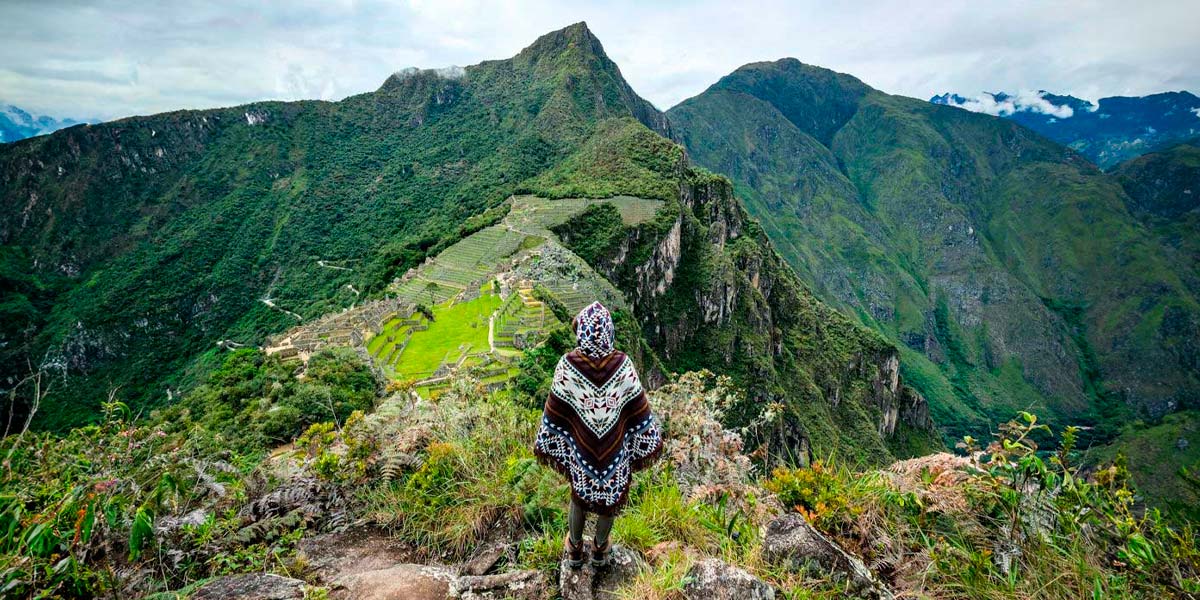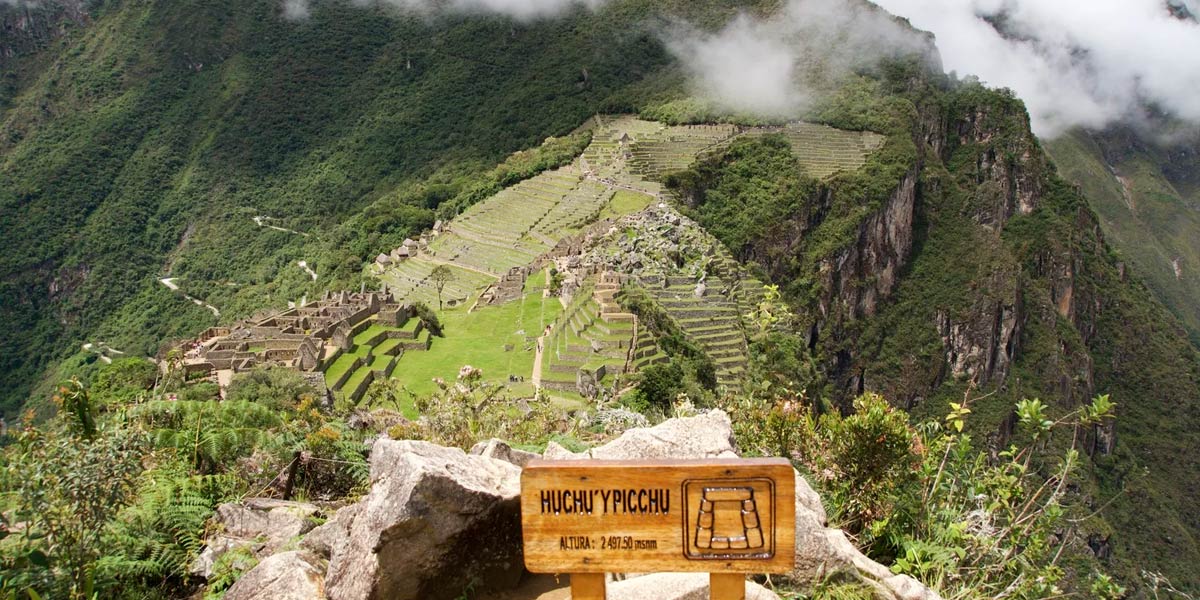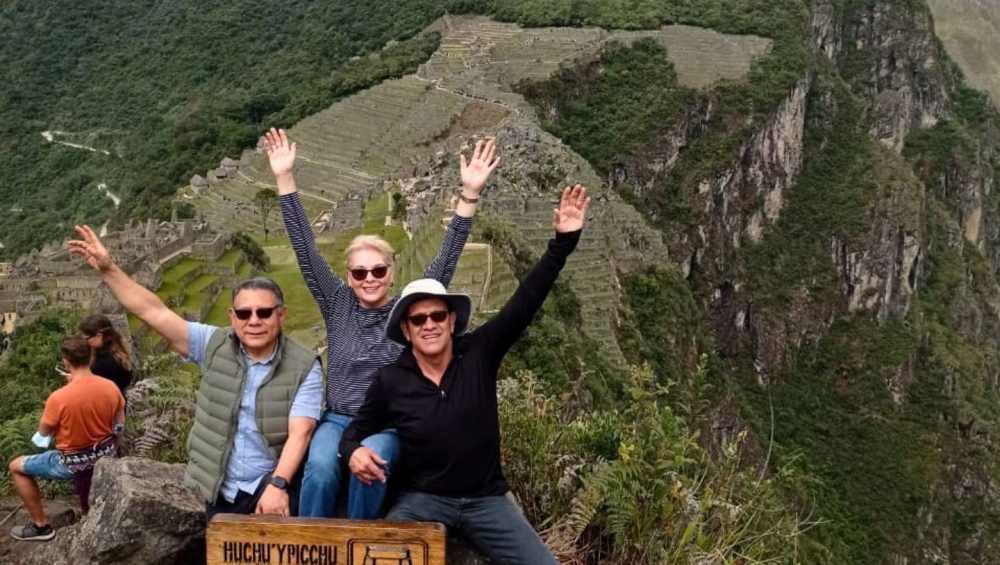Located in the Peruvian Andes and very close to the Machu Picchu citadel, the Huchuy Picchu mountain is the smallest of the three peaks that surround this archaeological site. Unlike Huayna Picchu and the Machu Picchu mountain, its ascent is shorter and simpler, ideal for travelers who want an accessible hike without the need for great physical effort. From the top, visitors get a different and panoramic view of the Inca citadel, surrounded by a wide Andean landscape.
What makes Huchuy Picchu special is its tranquility and its path, which is surrounded by vegetation typical of the Andean environment, offering unique opportunities for photography and contemplation. So, for those looking for new views of Machu Picchu, this trail offers the chance to experience the greatness of the Andes in a serene and authentic setting, making it an ideal alternative within the set of routes available in the sanctuary.
Meaning of the Name ‘Huchuy Picchu’
The name ‘Huchuy Picchu’ comes from Quechua, where huchuy means ‘small’ and picchu is used to mean mountains or peaks, although in some contexts it can also be linked with ‘splendor’ or ‘sacred mountain’. Together, its translation would be “Small Mountain”. However, the term should not be understood only as a reference to its size, since Huchuy Picchu has its own value within the Machu Picchu complex.
In the Andean tradition, the names of mountains were not random: they reflected their sacred nature, their role in the landscape, and their importance in the daily life of the people. Thus, Huchuy Picchu was not just a minor elevation, but a point of reference that offered a new view towards the citadel and its natural surroundings. Over time, this name remained as a symbol of the connection between the Incas and the mountains, considered guardians and protectors of the sacred valley.
Where is Huchuy Picchu Mountain?
Huchuy Picchu is located in the Cusco region, in southern Peru, within the archaeological complex of Machu Picchu. The mountain is in the heart of the Urubamba Valley, a place where winding rivers, imposing peaks, and Andean biodiversity combine to offer a unique and captivating landscape.
Height and Environment
Huchuy Picchu rises between 2,700 and 2,800 m.a.s.l., which makes it one of the most accessible mountains in the group. From its summit, visitors can appreciate a privileged view of Machu Picchu and the lush environment that surrounds it. The intermediate altitude of this mountain allows you to observe both the Andean vegetation and the transition to the jungle’s edge, as well as highlighting the Inca ceremonial constructions that are part of the landscape.
How to get to Huchuy Picchu mountain?
Getting to Huchuy Picchu mountain is simple and accessible for every traveler. From the main entrance of the Machu Picchu citadel, you just need to walk about 25 meters to the access point, located at the bottom. There you follow Circuit 3 – Machupicchu Royalty (Route 3-D: Huchuy Picchu Route), designed to explore the Inca citadel plus the walk to this mountain.
The entrance trail is shared with the one for Huayna Picchu, but when you get to the control where tickets are checked, you will find a fork. At that point, you must take the path to the left to begin the climb to Huchuy Picchu. Although less traveled than other routes, it offers stunning landscapes and the chance to enjoy a more peaceful and authentic walk, surrounded by nature and Inca remains.
With a guided tour
If you are looking for a complete and worry-free experience, opting for a guided tour is the best alternative. Hiring an organized tour guarantees that everything is covered: tickets, schedules, routes, and transport. This way you can focus only on enjoying the adventure.
Most of these tours include not only the walk to Huchuy Picchu, but also a detailed tour of the Machu Picchu ruins and, in some cases, additional routes in the surrounding areas. With the company of an expert guide, you will have access to historical explanations, curious facts, and little-known spots that will enrich your trip, making it an unforgettable experience.
Difficulty Level and Hike Time
The hike to the top of Huchuy Picchu is accessible for most visitors and does not require previous trekking experience. The trail is classified as having a moderate difficulty, since most of the route is simple and walkable. However, the final section has a steep and stepped slope that can be a challenge for those not used to walking at altitude. Even so, with a calm pace and short breaks, it is a climb that most manage to enjoy without major issues.
The average time to reach the summit is 30 minutes, although the complete journey, including stops to take photos and see the landscape, usually lasts between 40 minutes and an hour. It is not a long hike, but the slopes and the effort in the last meters make the arrival at the top feel like a true achievement. From there, you will see the unique panoramic view of Machu Picchu and its natural environment that is worth every step of the climb.

Tickets and Passes: What You Need to Know
Machu Picchu has three main circuits, each designed to show different sectors of the Inca citadel and its surroundings. Choosing the right Machu Picchu Entry Tickets is key, since what areas you can walk through and what additional mountains you will have access to visit depends on it.
If your goal is to discover the Huchuy Picchu mountain, a less crowded but charming destination, you must make sure to select the correct pass. This place not only offers a more intimate contact with the Andean landscape, but also the chance to explore Machu Picchu from a different angle than the traditional routes.
What Ticket Do You Need?
To access Mount Huchuy Picchu, it is essential to get the ticket for Circuit 3 – Machu Picchu Royalty Route, specifically Route 3-D: Huchuy Picchu. With this pass you can enter the lower sector of the citadel, where there are temples, ceremonial enclosures, and structures that show the extraordinary urban planning of the Incas.
Unlike other routes, like those that lead to Machu Picchu Mountain or Huayna Picchu, this trail does not offer wide panoramic views of the entire citadel. Instead, it provides a different experience: a more personal and calm route, ideal for those who come on a family trip with small children. Also, because the route is short and of moderate difficulty, it becomes a perfect option for those looking to add a little adventure to their visit without the need for long hikes.
Time of stay and tips
The visit to Huchuy Picchu has a maximum duration of 3 hours and 30 minutes, enough time to walk the route calmly, appreciate the natural surroundings, capture spectacular photos, and discover the history of this sector of Machu Picchu.
To make the most of your experience, keep these recommendations in mind:
- Comfortable and sturdy shoes: the path includes uneven sections.
- Enough water: there are no sales stands along the route.
- Sunscreen and hat: the radiation is intense even on cloudy days.
- Insect repellent: especially useful during the rainy season.
- Camera or smartphone: the viewpoints and archaeological structures offer excellent photo opportunities.
An extra tip is to start the route early in the morning. This way you will avoid the busiest hours and can enjoy a quieter experience.
What Inca constructions can you find on the route to Huchuy Picchu?
The Circuit 3-D: Huchuy Picchu ticket allows you to explore the lower part of the citadel, combining Inca architecture, Andean landscapes, and unique ceremonial spaces. The most notable points on the route are:
- Lower and upper platforms: agricultural terraces that show the engineering of the Incas.
- Dry moat: one of the first defensive lines of the city.
- Sun Temple Viewpoint: strategic point with views of one of the most sacred constructions.
- Temple Plaza and Granite Chaos: ceremonial area surrounded by huge stone blocks.
- Intiwatana Pyramid: space related to astronomical observations.
- Sacred Rock: an altar carved with great precision.
- Twelve niches: remains of Inca ceremonial architecture.
- Eastern Qolqas: old food warehouses.
- Game of water mirrors: enclosures where water was collected for rituals and sky observation.
- Temple of the Condor: one of the most impressive temples, with a shape that reminds of this sacred bird.
- Pisonay Plaza: a large space surrounded by residential buildings.
- Archaeological Reserve: a sector for the protection of structures under conservation.

Entry Times: Which to Choose?
Since all the Machu Picchu circuits are in high demand, it’s best to buy your ticket in advance. Before booking, think about the kind of experience you are looking for: a lighter walk with the morning coolness or a more relaxed visit at midday with different views. To choose well, consider their times:
First Time Slot (9:00 a.m.)
- Entry to Machu Picchu: from 9:00 a.m.
- Access to Huchuy Picchu: between 10:00 and 11:00 a.m.
Perfect for those who want to take advantage of the morning. The weather is cooler, the climb is comfortable, and the natural light provides clear photos. Also, there are usually fewer visitors at the top, which ensures a more peaceful experience.
Second Time Slot (11:00 a.m.)
- Entry to Machu Picchu: from 11:00 a.m.
- Access to Huchuy Picchu: between 12:00 and 1:00 p.m.
Ideal for those who prefer to explore the citadel first and then climb the mountain. Although the sun is at its highest point, the shadows on the ruins create a spectacular contrast for capturing unique photos.
Differences between Huchuy Picchu, Huayna Picchu and Machu Picchu Mountain
Huchuy Picchu, Huayna Picchu and Machu Picchu are part of the same archaeological site, but each mountain offers a different experience to the traveler. All share the greatness of the Inca culture and unique views of the citadel, although they differ in height, access difficulty, and type of route.
- Huchuy Picchu: With an approximate altitude of 2,497 m.a.s.l., it is the lowest of the three mountains. Its path is short and accessible, with a light walk of 30 to 45 minutes. It is ideal for those who seek an easy and safe ascent, without the need for great physical effort. From the top, you get a close panoramic view of Machu Picchu, perfect for photos and for those traveling with family or with limited time.
- Huayna Picchu: It is the most famous and demanded mountain. It rises to about 2,720 m.a.s.l. and its ascent is more demanding: narrow paths, steep steps, and dizzying passages that require good physical condition and caution. The walk lasts between 1 and a half to 2 hours. From the top, you can appreciate spectacular views of Machu Picchu and the Urubamba valley, in addition to accessing Inca constructions like the Temple of the Moon. It is the favorite option for adventurers who seek adrenaline.
- Machu Picchu Monuntain: At 3,082 m.a.s.l., it is the highest of the three. Its route is longer, with a walk of between 2 and a half to 3 hours, but less dangerous than Huayna Picchu. The route is ideal for those who enjoy long walks and want wide and clear views of the citadel, the Andean snow-capped mountains, and the Urubamba River canyon. From its top, the perspective is impressive and shows the magnitude of the natural environment that surrounds the ancient city.
In summary:
- Huchuy Picchu → Short, easy, and panoramic walk.
- Huayna Picchu → Challenging, steep route with exclusive Inca constructions.
- Machu Picchu Montaña → The highest, longest, and with wide views of the entire region.

